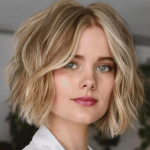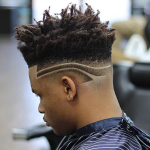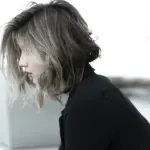Ragnar Lothbrok Haircuts
Ragnar Lothbrok’s hair on the hit shows Vikings may be one of the most awesome hairstyles we’ve ever seen on TV! The Ragnar Lothbrok hairstyle, made possible by actor Travis Fimmel, can be best characterized as a braided variation of a top knot or man ponytail with shaved sides. Although we probably wouldn’t recommend trying Ragnar’s haircut unless you already have a muscled body and look like a badass warrior, it’s cool to imagine growing your hair out and experimenting with this Viking haircut.
1. Ragnar Lothbrok’s Beard Styles:
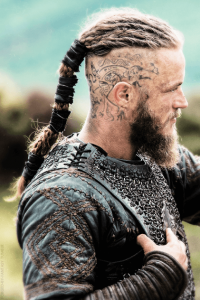
Ragnar Lothbrok wears a beard all throughout the T.V series the Vikings. There is no scene or episode where the actor is seen without a beard. His beard is long and well kept. It is shaped in a perfect ‘V’. Travis Fimmel grew his beard and maintained it on his own without the help of any professional and he did a fantastic job at it.
Throughout the show, Travis Fimmel is flaunting the varied lengths of beards. In the first season he is seen in a very shot well-groomed beard as the show progresses we see the beard length increase as well. His beard was mostly in a ‘V’ shape and was continues to grow in that direction.
His hairstyles along with his beard styles complimented each other well. The length of the beard depended upon the length of the hair too. The shorter the beard is the longer the hair, and, vice versa. This has been the trend on the show, and we’ve witnessed it.
2. The cute naive look:
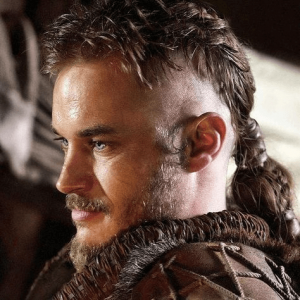
in the initial episodes, Ragnar is seen wearing a short beard, as the focus is supposed to be drawn onto his hairstyle rather than his beard as his beard is still in the process of growing out.
3 .well-groomed bearded with dreadlocks look:
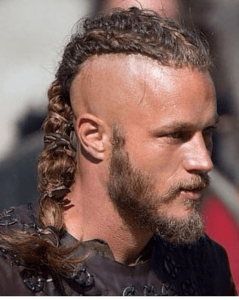
in the second and the third season when Ragnar’s beard is still growing he is shown with a very sophisticated beard and hairstyle. This suited his physique and his appearance a lot. He coupled this beard style with long dreads tied up together with a half-shaven head. This look was classic because of the beautiful eagle head tattoo.
4.The bald, but long bearded look:
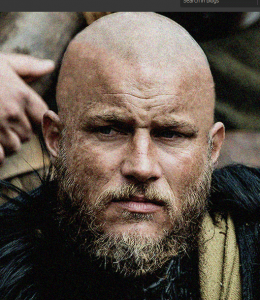
At the end of the third season, Ragnar is seen with a bald head and a beard which is very long. This look made him appear wise and powerful. It was perfect because at this time he is the ruler and his hair and beard style did justice to the role completely.
5. The manly look:
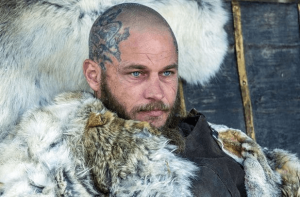
during the first two seasons, Ragnar grows his beard and by the third season, he has a powerful beard because he is to become the powerful Viking King. Since he had to play the role of a king, the team behind The Vikings played extra attention to his beard and hairstyle. Here his beard starts from his sideburns but he is bald on the sides of the head with a ‘V’ at the back.
6. Ragnar Lothbrok braids:
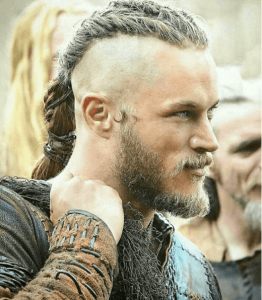
Ragnar looks dashing with braids on the TV series. He wears these in the series with his head shaven from both sides of the braid. There are multiple braids that are made beginning from the temple and the French braid goes all the way to the back. He compliments this look with a beard that is short and a mustache. The beard starts from the temple region and extends to the chin.
7. Ragnar Lothbrok Haircuts with short Curls
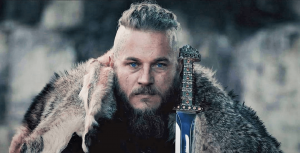
in the second and the third season when Ragnar’s short curls are still growing he is shown with a very sophisticated beard and hairstyle. This suited his physique and his appearance a lot. He coupled this beard style with long dreads tied up together with a half-shaven head.
8.Ragnor Mohawk with Huge, Round Beard:
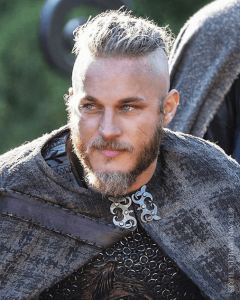
If you want your Viking hairstyle to have even more of a bad boy edge to it, pair it with a mohawk! Although we don’t particularly recommend fanned punk mohawks for the Viking aesthetic, we do encourage you to opt for wider mohawks and fully shaved sides
9. Ragnar Haircuts 1 – Crew Cut with Beard:
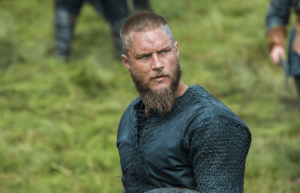
What if you love Vikings, but aren’t up for dealing with the maintenance that comes with long hair? Then combine your rough beard with an easier haircut, such as the crew cut. Add an undercut to the mix for extra style.
10.Ragnar Lothbrok extensions Haircuts:
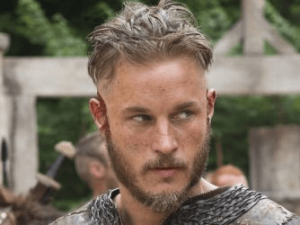
In this series, he’s also sometimes seen wearing extensions hair. If you wish to style hair extensions easiest way to get them is at the salon. A professional perfect barber will be able to do the cool job at adding extensions to the hairs.
11.Ragnar Lothbrok Short Haircuts:
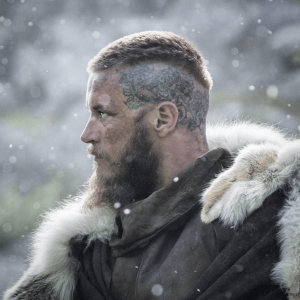
in this series, Travis Fimmel is also seen wearing shorter hair. Well, short hair is an understatement. In few episodes of the series, he’s shown to have short hair. He’s also bald with the hair only on a middle part region of the head. At back there’s a Viking of sorts. This haircut is complete with the tattoos on the bald part of the whole head.
Ragnar Lothbrok Haircut Messy With Beard
![]()
Here’s an overview of Viking history:
The history of the Vikings is a fascinating and complex one, spanning several centuries and encompassing a wide range of activities and achievements.
- Origins of the Vikings (Late 8th Century): The term “Viking” refers to seafaring people from the late 8th to early 11th century who came from the Scandinavian countries of Norway, Denmark, and Sweden. The exact origins of the Vikings are still debated, but factors such as overpopulation, limited arable land, and a desire for wealth and adventure likely played a role in their expansion.
- Viking Raids (Late 8th Century – Early 9th Century): The Vikings are perhaps best known for their raids on European coastlines. They targeted monasteries, towns, and villages, plundering and pillaging for treasure, slaves, and food. These raids, while brutal, were also opportunistic responses to economic and political conditions of the time.
- Viking Expansion (Late 8th Century – 11th Century): Over time, Viking expeditions expanded westward to the British Isles, Ireland, Scotland, and as far as Iceland, Greenland, and even North America (Vinland). To the east, they ventured into the Baltic region, Russia, and eventually reached as far as the Black Sea and Constantinople.
- Viking Settlements: Vikings not only raided but also established settlements in the areas they conquered. The Danelaw in England and the Norman invasion of England, led by William the Conqueror, were significant Viking legacies in the British Isles. In France, the Vikings established the Duchy of Normandy.
- Conversion to Christianity: Initially, Vikings practiced Norse paganism, but over time, many converted to Christianity. This shift had profound cultural and political implications and contributed to their integration into European societies.
- Viking Society: Viking society was organized into chieftain-led clans, with a warrior elite and farmers making up the majority of the population. Women had more rights and independence in Viking society compared to many other medieval cultures.
- Viking Ships: The Vikings were renowned shipbuilders and navigators. Their longships, with their shallow draft and oars, allowed them to navigate rivers and oceans, giving them a strategic advantage in raids and exploration.
- End of the Viking Age (Late 11th Century): The Viking Age is traditionally considered to have ended with the Norman Conquest of England in 1066, led by William the Conqueror, who was of Viking descent. Additionally, the spread of Christianity and the consolidation of European kingdoms contributed to the decline of Viking activities.
- Legacy: The Vikings’ impact on European history is significant. They left behind a rich cultural heritage, including sagas, art, and runes. They also played a role in shaping the political landscape of Europe through their settlements and conquests.
Today, the Vikings continue to capture the popular imagination through literature, movies, and television, often romanticized as legendary warriors and explorers who left a lasting mark on the history of Europe and beyond.
